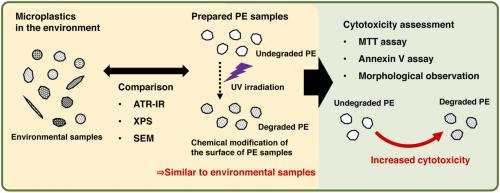当前位置:
X-MOL 学术
›
Ecotox. Environ. Saf.
›
论文详情
Our official English website, www.x-mol.net, welcomes your feedback! (Note: you will need to create a separate account there.)
Polyethylene, whose surface has been modified by UV irradiation, induces cytotoxicity: A comparison with microplastics found in beaches
Ecotoxicology and Environmental Safety ( IF 6.8 ) Pub Date : 2024-04-25 , DOI: 10.1016/j.ecoenv.2024.116346 Yudai Ikuno , Hirofumi Tsujino , Yuya Haga , Sota Manabe , Wakaba Idehara , Mii Hokaku , Haruyasu Asahara , Kazuma Higashisaka , Yasuo Tsutsumi
Ecotoxicology and Environmental Safety ( IF 6.8 ) Pub Date : 2024-04-25 , DOI: 10.1016/j.ecoenv.2024.116346 Yudai Ikuno , Hirofumi Tsujino , Yuya Haga , Sota Manabe , Wakaba Idehara , Mii Hokaku , Haruyasu Asahara , Kazuma Higashisaka , Yasuo Tsutsumi

|
Microplastics, plastic particles 5 mm or less in size, are abundant in the environment; hence, the exposure of humans to microplastics is a great concern. Usually, the surface of microplastics found in the environment has undergone degradation by external factors such as ultraviolet rays and water waves. One of the characteristics of changes caused by surface degradation of microplastics is the introduction of oxygen-containing functional groups. Surface degradation alters the physicochemical properties of plastics, suggesting that the biological effects of environmentally degraded plastics may differ from those of pure plastics. However, the biological effects of plastics introduced with oxygen-containing functional groups through degradation are poorly elucidated owing to the lack of a plastic sample that imitates the degradation state of plastics found in the environment. In this study, we investigated the degradation state of microplastics collected from a beach. Next, we degraded a commercially available polyethylene (PE) particles via vacuum ultraviolet (VUV) irradiation and showed that chemical surface state of PE imitates that of microplastics in the environment. We evaluated the cytotoxic effects of degraded PE samples on immune and epithelial cell lines. We found that VUV irradiation was effective in degrading PE within a short period, and concentration-dependent cytotoxicity was induced by degraded PE in all cell lines. Our results indicate that the cytotoxic effect of PE on different cell types depends on the degree of microplastic degradation, which contributes to our understanding of the effects of PE microplastics on humans.
中文翻译:

表面经过紫外线照射改性的聚乙烯会产生细胞毒性:与海滩中发现的微塑料的比较
微塑料,即尺寸为 5 毫米或更小的塑料颗粒,在环境中大量存在;因此,人类接触微塑料是一个令人高度关注的问题。通常,环境中发现的微塑料表面已因紫外线和水波等外部因素而发生降解。微塑料表面降解引起的变化特征之一是引入含氧官能团。表面降解改变了塑料的物理化学性质,这表明环境降解塑料的生物效应可能与纯塑料不同。然而,由于缺乏模拟环境中塑料降解状态的塑料样品,通过降解引入含氧官能团的塑料的生物效应尚不清楚。在这项研究中,我们调查了从海滩收集的微塑料的降解状态。接下来,我们通过真空紫外线 (VUV) 照射降解市售聚乙烯 (PE) 颗粒,结果表明 PE 的化学表面状态模仿了环境中微塑料的化学表面状态。我们评估了降解的 PE 样品对免疫和上皮细胞系的细胞毒性作用。我们发现 VUV 照射可在短时间内有效降解 PE,并且在所有细胞系中降解的 PE 都会诱导浓度依赖性细胞毒性。我们的研究结果表明,PE 对不同细胞类型的细胞毒性作用取决于微塑料降解的程度,这有助于我们了解 PE 微塑料对人类的影响。
更新日期:2024-04-25
中文翻译:

表面经过紫外线照射改性的聚乙烯会产生细胞毒性:与海滩中发现的微塑料的比较
微塑料,即尺寸为 5 毫米或更小的塑料颗粒,在环境中大量存在;因此,人类接触微塑料是一个令人高度关注的问题。通常,环境中发现的微塑料表面已因紫外线和水波等外部因素而发生降解。微塑料表面降解引起的变化特征之一是引入含氧官能团。表面降解改变了塑料的物理化学性质,这表明环境降解塑料的生物效应可能与纯塑料不同。然而,由于缺乏模拟环境中塑料降解状态的塑料样品,通过降解引入含氧官能团的塑料的生物效应尚不清楚。在这项研究中,我们调查了从海滩收集的微塑料的降解状态。接下来,我们通过真空紫外线 (VUV) 照射降解市售聚乙烯 (PE) 颗粒,结果表明 PE 的化学表面状态模仿了环境中微塑料的化学表面状态。我们评估了降解的 PE 样品对免疫和上皮细胞系的细胞毒性作用。我们发现 VUV 照射可在短时间内有效降解 PE,并且在所有细胞系中降解的 PE 都会诱导浓度依赖性细胞毒性。我们的研究结果表明,PE 对不同细胞类型的细胞毒性作用取决于微塑料降解的程度,这有助于我们了解 PE 微塑料对人类的影响。



























 京公网安备 11010802027423号
京公网安备 11010802027423号